If you just signed up for HBO MAX for the Snyder Cut of JUSTICE LEAGUE, do yourself a favor and check out an overlooked original gem the streamer offers: DOOM PATROL, starring White Collar‘s Matt Bomer as Negative Man, Brendan Fraser as Robotman and Timothy Dalton as The Chief. Since Doom Patrol is just about as obscure as it gets, I thought it made sense to re-introduce them to viewers unfamiliar…
The year: 1963. A new superhero team is introduced to the world, featuring a group of social misfits, whose freakish powers mark them as different from the world around them. Scorned and feared by humanity, these outcasts are gathered by their mysterious wheelchair-bound leader, who convinces them to use their gifts to protect a world that shuns and ostracizes them.
And it’s not the X-Men.
In fact, the first appearance of DC Comics’ Doom Patrol predates the first appearance of Marvel’s team of mutants by a mere three months, too close to be anything but sheer coincidence. As Doom Patrol creator Arnold Drake describes in the foreword to the first DC Archives collection of Doom Patrol, DC was just starting to react to changing times in 1963, both in the world at large and in the comic-book industry. Particularly, Stan Lee’s revolutionary new approach at Marvel was having an impact, with the result that DC’s anthology books like STRANGE ADVENTURES, HOUSE OF MYSTERY and MY GREATEST ADVENTURE were all starting to suffer in sales. In response, MY GREATEST ADVENTURE editor Murray Boltinoff assigned Drake to come up with a super-hero feature to keep MGA from the chopping block. Drake, with an assist from writer Bob Haney, came up with the Doom Patrol, a team of misfits who continually save the day in spite of their resentment at society in general — a new approach to superheroes, which even in 1963 was getting harder and harder to come by.
The uncanny similarities between the Doom Patrol and the X-Men have often generated curiosity among comic fans. While the publishing dates between the two are too close for one to have been openly inspired by the other, some have wondered if either company might have heard through the grapevine what their competition was working on, and rushed their own version into print in a race to claim the ground first. It’s an understandable theory; aside from the near-identical concepts and the wheelchair-bound leaders, the books also have very similar taglines (The Doom Patrol’s “The World’s Strangest Heroes!” versus the X-Men’s “The Strangest Super-Heroes of All!”) and their primary antagonists seem to share a name as well (the Doom Patrol frequently faced the Brotherhood of Evil, while the X-Men had to contend with the Brotherhood of Evil Mutants). Regardless, I’ve seen no hard evidence that would lead me to suggest that the Doom Patrol/X-Men synchronicity was anything more than a case of talented creatives thinking alike.
For the art on this risky new feature, editor Boltinoff was unable to use any of his top artists, and went with an artist who had mostly worked on DC’s mystery and Western titles, Italian and Argentine expatriate Bruno Premiani. As we’ll see, the mostly unknown Premiani turned out to be perfectly suited to the title, having an innate sense of the style needed for this very special kind of superhero book. Let’s now meet the Doom Patrol, from their self-titled debut in MY GREATEST ADVENTURE #80 (June 1963). The story opens in a mysterious shadowy chamber, where a bearded man in a wheelchair is addressing three silhouetted figures.
The man cruelly chastises them, calling them quitters and outcasts, and accusing them of wallowing in self-pity. Addressing them one by one, the man recounts the story of Rita Farr, a beautiful Hollywood actress who accidentally inhaled mysterious underground vapors while on location in Africa. As a result of the exposure, Rita found herself changing size, ranging from a colossal giant to an inch-high mite.
Unable to control her power, Rita gave up her movie career and fled from the public eye. Even though she had since learned to change her size at will, Rita refused to rejoin the world.
Next, the mysterious crippled man addresses Larry Trainor, who, we see, is swathed head to toe in bandages. Larry, a test pilot, was taking an experimental rocket plane higher than any manned aircraft had ever flew when his controls seized up, and the plane hurtled to Earth. Larry managed to retain enough control to crash-land the plane safely on a dry lake-bed. Larry watched as a rescue plane descended to pick him up, but noticed in horror that only one of the plane’s wheels had lowered.
With just seconds before the rescue plane crashed, Larry was shocked to witness a strange glowing black figure emerge from his body, fly up to the plane and lower the wheel. The wheelchair-bound figure speculates that “unknown wave belts bombarding [Trainor’s] body” on the test flight was what created the mysterious “Negative Man.” However, Larry retorts that it’s not without cost: while Negative Man is out, Larry is barely conscious, and if Negative Man doesn’t return to Larry’s body within 60 seconds, Larry will die. Even more so than Rita, Larry refuses to return to the outside world.
Emerging from the shadows, startling the others, is an orange robot. This is Cliff Steele, who is perhaps the most bitter of all at his tragic situation. Cliff was a daredevil and racecar driver, who suffered a horrific auto accident on a European race track. Cliff came to in the hospital, hearing the doctors say that his body was beyond repair. Cliff faded into unconsciousness, and awoke to the sight of his orange metal hands.
Only Cliff’s brain had survived, and had been transplanted into a robotic body. Cliff tried to return to his former life of sports and daredevil stunts, but found only rejection and disfavor. Cliff asks why he shouldn’t feel bitter.
The man in the wheelchair replies that Cliff doesn’t realize how unique he is, invulnerable and incredibly strong, and he should know, because he was the surgeon that transplanted Cliff’s brain into his new body. The man beckons the three recluses to follow him further into his enormous headquarters, taking them to the Nerve Center, where he can monitor the world for emergencies. While he can’t go and be of assistance when disaster strikes, the three of them could, with him remaining behind to guide and instruct them. Before they can refuse him once again, an alert comes in about a time bomb in a populated area. The man asks Larry to help, and gives him a special device that will locate the bomb much more quickly than the police can. Negative Man bursts from Larry’s body, takes the detector, then hurtles to the pier, finds the bomb, and retrieves it, returning safely to Larry’s body.
The man then instructs Rita to shrink down and enter the bomb, while he talks her through he defusing process, all while Cliff holds the bomb tightly against his metal body, hoping to smother the blast and save Larry and the man in the wheelchair, should the worst happen. Rita succeeds, and the threat is averted, and the three outcasts are now inspired to use their abilities in service of society, under the leadership of the man they would come to know only as “the Chief.”
Unlike the X-Men, whose members would occasionally comment on their outcast status, the Doom Patrol positively wallowed in it, with barely an issue going by without one or all of the members either bemoaning their fates or cursing the outside world for judging them on their appearance, such as in this moment from MGA #84:
It’s interesting to note that the Doom Patrol absolutely never referred to themselves by “superhero” names — you might see Elasti-Girl or Robotman referred to on the cover or being spoken by an enemy, but among themselves, it was always Cliff, Larry and Rita. Even Stan Lee’s FANTASTIC FOUR, which had broken the mold by doing away with secret identities, still fell back on the superhero codenames from time to time.
One of the Doom Patrol’s most tenacious foes was General Immortus, an ancient criminal mastermind who had lived for centuries, and was obsessed with finding the key to immortality. Despite the fact the seemingly every encounter with the Doom Patrol wound up with Immortus being presumed dead, time and time again, he’d resurface with bad intentions for the Chief and company.
Immortus also played a part in the Chief’s early days as well, as recounted in DOOM PATROL #88 (the magazine’s title having been changed from MY GREATEST ADVENTURE), in “The Incredible Origin of the Chief!” At the news of Immortus’ latest return, the Chief finally agrees to explain their history together. The Chief tells of his time spent in poverty as a young scientist doing medical research, despite the vast money he could have made putting his skills to work in engineering. When the young Chief’s (whose name is revealed here as Niles Caulder) resources are at their lowest, he’s met by an emissary of Immortus, who gives Caulder a grant of 2 million dollars, on the condition that when Caulder can extend human life, Immortus be the first man on whom he tests the process. When Caulder’s work is complete and he’s discovered the secret of immortality, he pits his genius to work discovering the location of his mysterious benefactor, and is shocked to learn that he’s been in the employ of criminals. Caulder is captured by Immortus’ men, and the crimelord’s surgeons implant a bomb in Caulder’s chest, to be removed only when Caulder gives him the secret.
Instead, Caulder attacks Immortus in the night, forcing the ancient criminal to fatally shoot him, rendering the bomb moot, then stumbles back to his lab before dying, where his loyal robot assistant RA-2 is waiting to perform the operation to remove the bomb. Unfortunately, Caulder was on the table too long before being resuscitated, and as a result lost the use of his legs. After awakening, Caulder destroyed his notes and his lab and went into hiding, so that Immortus could never reconstruct his work. In a sad and somewhat morose moment, Caulder even “assassinates” RA-2, the robot that had saved his life.
General Immortus wasn’t the only villain to repeatedly darken the Doom Patrol’s door. Another frequent opponent was the Brotherhood of Evil (another odd parallel to the X-Men, who faced a similarly named group in Magneto’s Brotherhood of Evil Mutants). Probably one of the wackiest supervillain teams around, the Brotherhood, purportedly “the most powerful crime syndicate in the world,” consisted of the Brain, nothing more than a disembodied brain floating in a fishbowl, his assistant Monsieur Mallah, a machine-gun-toting gorilla granted genius intelligence and the ability to speak by the Brain, and Madame Rouge, a French schoolteacher first utilized as a master of disguise, and later given shape-changing powers by the Brain, allowing her either to alter her appearance or stretch and contract her limbs.
Here’s where the realistic, classical art style of artist Bruno Premiani really served as a boon to the series. The Brotherhood looked menacing and disturbing precisely because they looked so real: rather than going with a slavering, cartoony likeness for Mallah, he looks like a photorealistic normal gorilla, which is pretty creepy when he’s wearing gloves and packing heat.
Premiani’s realistic art style was a great asset to the series in general, in that his characters looked so much more authentic than some of the stylized work being done by his DC contemporaries like Gil Kane and Carmine Infantino, which served as an excellent juxtaposition to some of the more outlandish aspects of the series. At first dressed in normal civilian clothes, even when the Doom Patrol got “costumes,” they were more like traditional work coveralls than flashy tights. Premiani also had a real facility with faces and likenesses, with a facility for expressing emotion through the face, particularly with the Chief and Rita.
Beautiful and kind-hearted, Rita inspired affection in both Cliff and Larry, as well as someone else, millionaire Steve Dayton, who took up the super-hero identity Mento (complete with a helmet created by his scientists that granted him mental powers) merely so he could meet up with Rita on adventures, with the intention of wooing her away from her life with the Doom Patrol.
After a bumpy courtship, Steve “the Freshmaker” Dayton won out — sort of. While Rita and Steve did finally get married (and would eventually adopt the orphaned shapeshifting child Gar Logan, who would later go by the names Beast Boy and Changeling as a member of the Teen Titans), Steve was never able to convince Rita to give up her friends in the Doom Patrol.
To go back to Premiani’s art for a moment, there was another aspect of Premiani’s classical, almost commercial style that worked so well with the series: the characters’ powers occasionally manifest themselves in a visually bizarre, almost disturbing fashion, illustrated with a creepy simplicity by Premiani. For instance, here’s a scene where Rita learns to only grow a part of her body:
Or here, when Larry finally removes his bandages, revealing the extent to which he’d been poisoned by radiation: rendering his very flesh invisible.
But worst of all in this department was poor Cliff. Half the time, DOOM PATROL seemed more like a superhero snuff film, as Drake and Premiani found new ways to dismember, melt, perforate or otherwise maim Robotman, all while Cliff usually looked on, horrified, waiting for whatever atrocity was mutilating his body to eventually reach his vulnerable human brain. Just off the top of my head, Cliff was melted…
…run through a press…
…beheaded…
…used as a drill, you name it.
Even worse, it was established in their first appearance that Cliff’s senses still functioned, so all of these horrible injuries he suffered? He felt every one of them. My personal favorite was from DOOM PATROL #87, in which Robotman is sent on a solo mission by the Chief, in pursuit of a fugitive killer, along the way, all of Cliff’s limbs are rendered useless, with Cliff using them as weapons and tools, such as tearing off his own leg and molding it into a key, using his right leg as a boomerang, and ripping off his own arm with his jaw, and smashing a tank with it.
That’s hardcore. Eventually Cliff, who’s now just a torso, headbutts the killer and pins him under the weight of his own torso to ensure that he doesn’t get away.
The Doom Patrol’s swan song was just as unusual as the rest of their adventures. In the face of declining sales (down to only 250,000 a month, staggering by today’s standards), the book was cancelled in 1968 with issue #121, and unlike any other superhero series, the book ended with the death of the team, as the Chief, Larry, Rita and Cliff agree to sacrifice their lives in exchange for the lives of a small New England fishing village of only 14 inhabitants, held captive by a former Nazi captain and their old enemy Madame Rouge. The four go out together, holding hands as the Nazi detonates the small island on which they were captured.
The original Doom Patrol run can be found in DC’s Archive collections if you look hard enough. Highly recommended.
The Doom Patrol stayed dead until 1977, when a resurrected Robotman (whose head apparently survived the blast) joined with Arani Caulder, a woman who claimed to be Niles Caulder’s previously unknown wife, Valentina Vostok, a Russian pilot who seemed to have become the new host for Larry Trainer’s negative being, and Joshua Clay, a Vietnam vet with the ability to generate force blasts, to form a new Doom Patrol. This version of the team only lasted three issues in DC’s revived anthology book SHOWCASE, and was then quickly forgotten.
With Beast Boy’s membership in NEW TEEN TITANS as Changeling, many of the Doom Patrol appearances and villains began making appearances there, including Cliff Steele, who helped Changeling find his stepfather Steve Dayton and achieve a measure of revenge against Madame Rouge for the murder of his adoptive mother Rita.
In 1987, the series was revived again, this time by writer Paul Kupperberg and artist Steve Lightle. It was pretty standard superhero fare, at least until issue #19, when writer Grant Morrison took over the book, and it transformed from a run-of ‘the-mill punch’em-up to a monthly exercise in surrealism and representational symbolism. Soon the book had changed so drastically that it was transferred to DC’s then-new Vertigo imprint for more mature-themed horror comics.
Morrison’s work on DOOM PATROL is at times both sheer genius and totally baffling, with the team, anchored by Cliff and the resurrected Chief, taking on new members such as Rebis, a hermaphroditic merging of Larry Trainor and his physician, Eleanor Poole, Crazy Jane, who suffered from multiple-personality disorder and had a different superpower for each persona, Dorothy Spinner, a freakish apegirl with the power physically manifest images from her subconscious, and Danny the Street, a sentient transvestite street that served as the team’s mobile headquarters. The new DP faced such nontraditional threats as the Beard Hunter (who was, logically enough, after the Chief’s beard), Shadowy Mr. Evans, and the Men from N.O.W.H.E.R.E., as well as the reappearance of old foes like the Brain and Monsieur Mallah, who, surprisingly, declared their love for one another. Also, succeeding the Brotherhood of Evil was the Brotherhood of Dada, a new group of supervillains dedicated to celebrating the absurdity of life itself.
It’s even weirder than it sounds, believe it or not. I recommend Morrison’s DOOM PATROL run simply because there’s nothing else like it.
The Doom Patrol hasn’t had much exposure in recent years, save for a fairly brilliant appearance on Cartoon Network’s THE BRAVE AND THE BOLD, which actually had the nerve to tell the Doom Patrol’s most famous story — their sacrifice — for television:
Do yourself a favor and pick up the DVD.

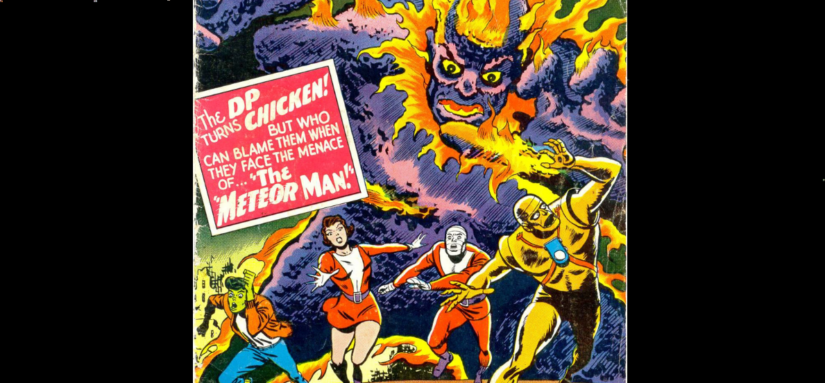


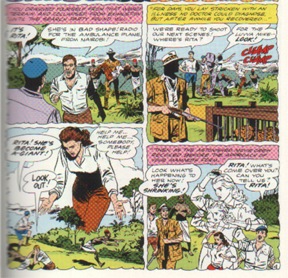

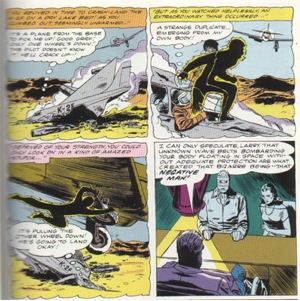


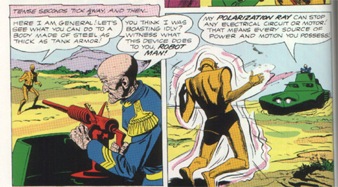
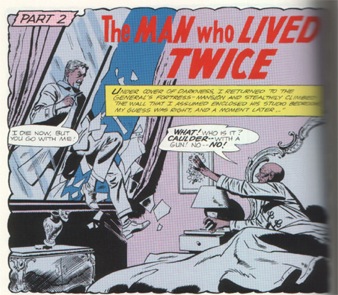
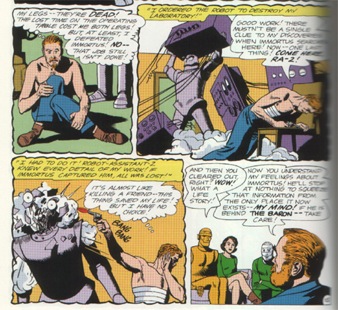






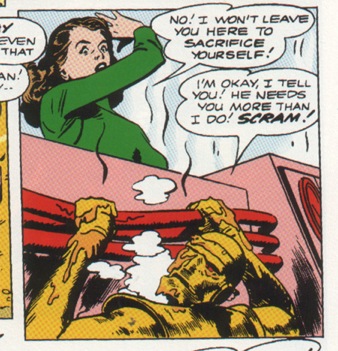



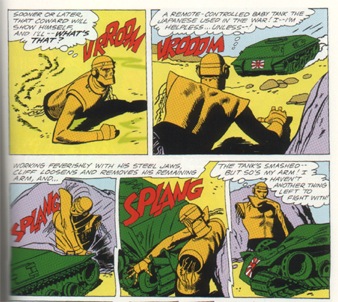






Comments are closed.